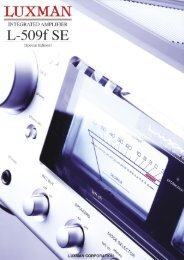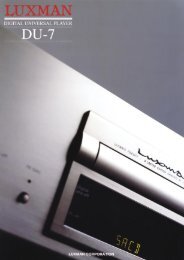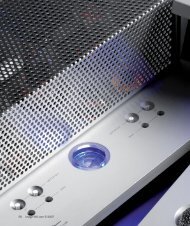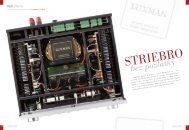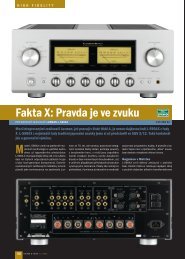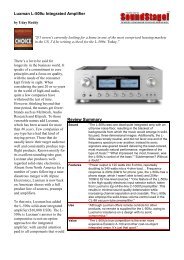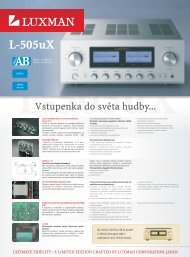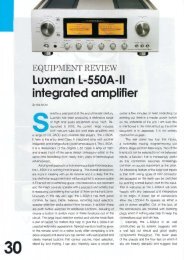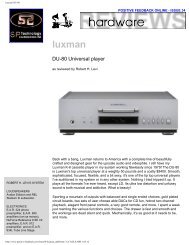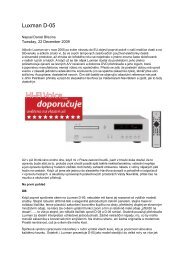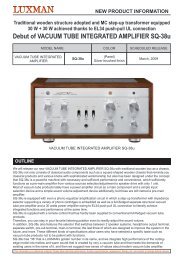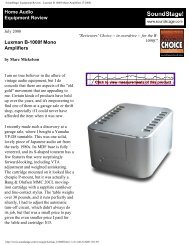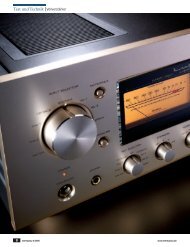LUXMAN L-505u - test (EN)
LUXMAN L-505u - test (EN)
LUXMAN L-505u - test (EN)
Create successful ePaper yourself
Turn your PDF publications into a flip-book with our unique Google optimized e-Paper software.
While the Luxman was in house, Winston Ma of FIM recordings sent<br />
me a new CD release called “Grooving Classics” (FIM #XR24 044).<br />
Sounds like something right out of the 70’s maybe…but no. The title<br />
“Grooving Classics” to me is a bit misleading, in that when I hear<br />
“grooving”, I think hot bass, drum and guitar tracks. There are no<br />
guitars, no bass players, but there are loads of drums! What we have<br />
here is a very unique blend of the Colorado String Quartet and the Ethos<br />
Percussion Group under the direction and arrangement of Harold<br />
Farberman, a former student of Aaron Copeland among other accolades.<br />
Eight very accomplished musicians in all.<br />
The “Classics” part of the title is accurate because all of the ten cuts are titles such as “Eine Kleine<br />
Nachtmuzik”, “Adagio” from the New World Symphony, and variations of Haydn’s “Surprise<br />
Symphony”. Each is arranged specially for the combined quartets with many liberties taken as far as<br />
instrumentation and orchestration, but each remains fairly consistent with the original tempo, feel<br />
and temperament. In other words, the three dances from “The Nutcracker” are not re-arranged as<br />
Bee-Gees style disco and “Red River Valley” does not sound like Tammy Wynette, though at times<br />
the marimba, castanets and other plucks and crashes were a bit Zappaesque.<br />
For this particular, project Winston borrowed none other than Reference Recording’s Professor<br />
Johnson; arguably the best recording engineer anywhere. The recording was completely analog on a<br />
½ custom tape machine, and In addition to that, the analog was mastered by the great Paul<br />
Stubblebine and then mastered as a JVC XRCD24. We’re talking a real dream team here. I know<br />
I’m being repetitious, but here again, even with this ultra quality CD, the Luxman, well, I almost<br />
said “shone”. But it didn’t. It just played the music without calling any attention to itself – other<br />
than some wild careening on the part of the cool power meters, showing me the capacious dynamics<br />
I was hearing. Did I say they were “cool”?<br />
Speaking of power, Luxman was (and apparently still is) notorious for vastly understating their<br />
amplifiers output ratings. Saying the <strong>505u</strong> is “conservatively” rated at 100 wpc would be a<br />
conservative statement in itself. Power was never an issue.<br />
Man. I’m already at 4,000 words here, even though there’s much more to say, like comparing it to<br />
other amps and describing many more recordings. If you’ve gotten this far, I think you get the gist<br />
of what the <strong>505u</strong> is all about and whether it might be what you’re looking for.<br />
I’ll close with this: Harkening back to the 70’s, I wish Luxman would offer their classic burnished<br />
gold metal finish at least as an option. Those early Lux’s just glowed and oozed subtle luxury<br />
without being ostentatious. And it would still have all that balance.<br />
There is a lot to consider when thinking about the Luxman.The size is one. This is not a Cambridge<br />
or NAD. It plays in a bigger league, though if you are going from separates to an integrated which<br />
many are doing, that's not an issue. One thing Linda noted was that not so many wires were<br />
showing - a big plus. The styling is another issue. If you like it, there's not much else out there that<br />
has that classic look - especially the meters. If you have a spouse, Linda also loved the ease of



